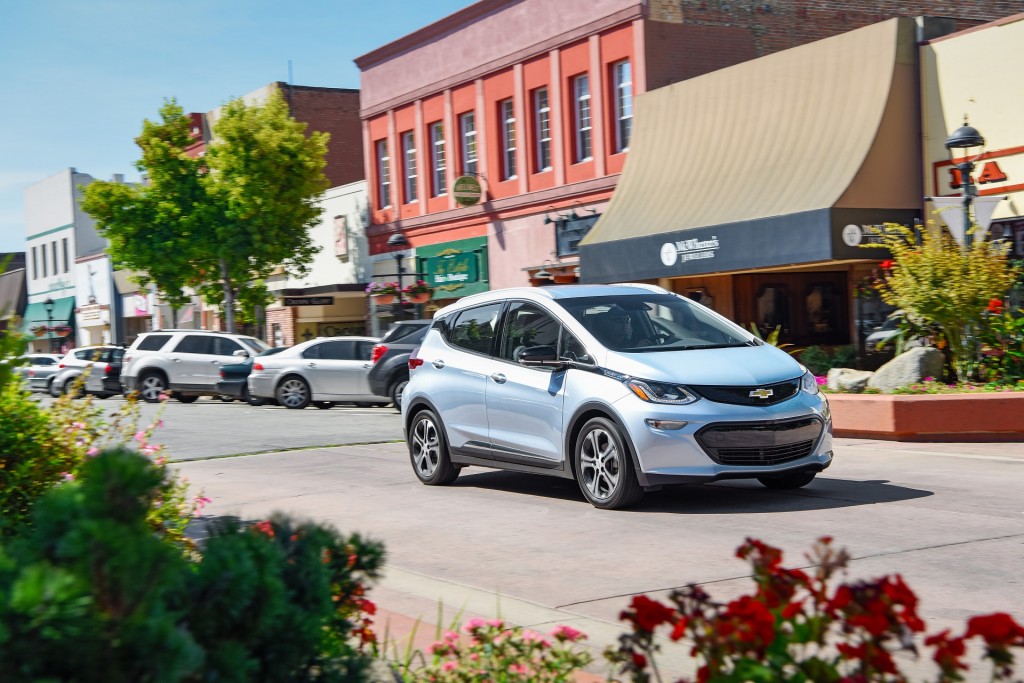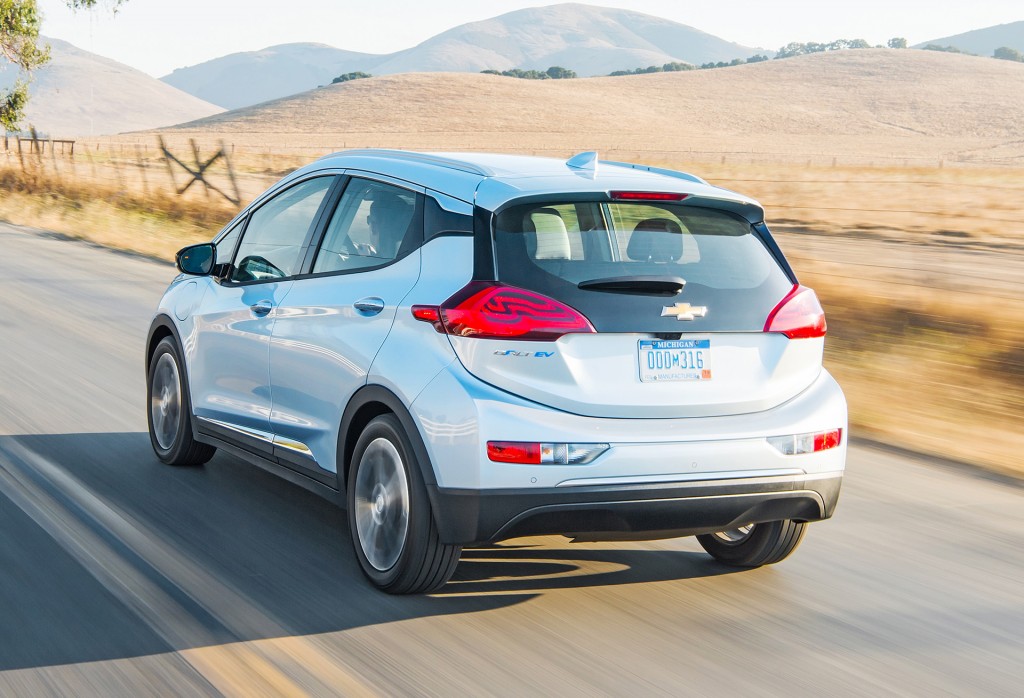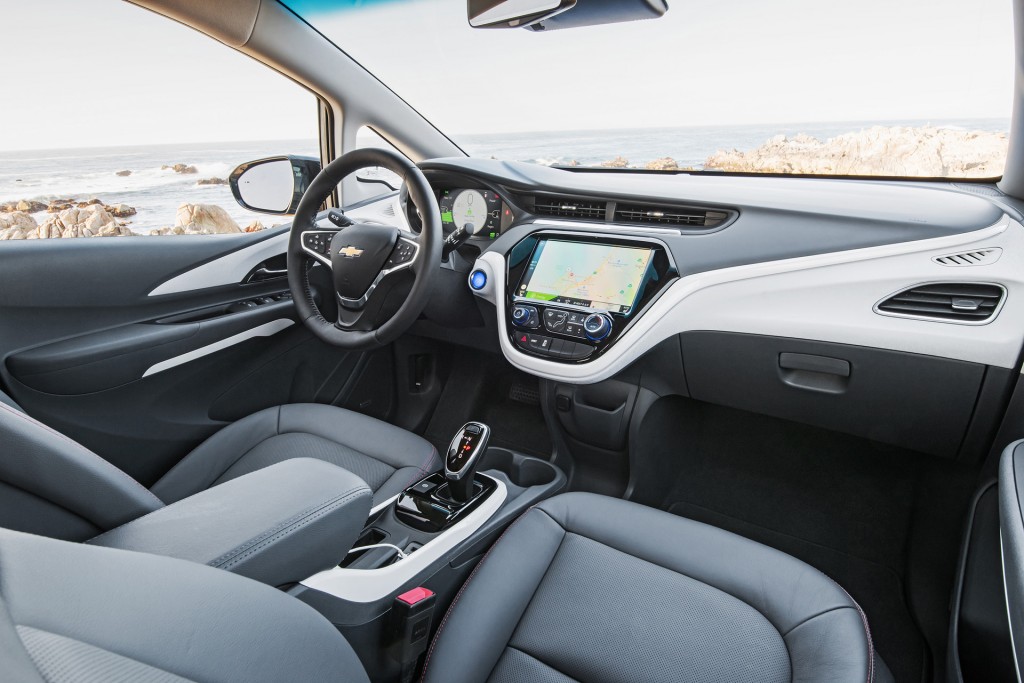![2017 Chevrolet Bolt EV electric cars outside dealership [photo: Patrick Reid] 2017 Chevrolet Bolt EV electric cars outside dealership [photo: Patrick Reid]](https://images.hgmsites.net/lrg/2017-chevrolet-bolt-ev-electric-car-photo-patrick-reid_100605961_l.jpg)
2017 Chevrolet Bolt EV electric cars outside dealership [photo: Patrick Reid]
The 2017 Chevrolet Bolt EV is the first mass-priced electric car to offer a range of more than 200 miles, something previously offered only by pricey Tesla luxury cars.
Initially put on sale last December in California, the 238-mile Bolt EV is slowly rolling out across the country and will be on sale in every state by September.
How many Chevy sells remains to be seen, as the same challenges in creating suitable marketing messages and overcoming dealership challenges remains.
DON'T MISS: 2017 Chevy Bolt EV electric car: new owner's first impressions
But increasing numbers of buyers—several thousand of them to date—are now putting miles on their Bolt EVs and reporting on their experiences.
In fact, Chevrolet said in the last week of April, those drivers had already covered more than 4.5 million miles in their all-electric cars.
Real-world experiences by actual owners are often popular among advocates, shoppers, and those considering whether a car that plugs in could really make sense for them.
![First 2017 Chevrolet Bolt EV electric car [photo: Patrick Reid] First 2017 Chevrolet Bolt EV electric car [photo: Patrick Reid]](https://images.hgmsites.net/lrg/2017-chevrolet-bolt-ev-electric-car-photo-patrick-reid_100605959_l.jpg)
First 2017 Chevrolet Bolt EV electric car [photo: Patrick Reid]
So we were delighted to get a note out of the blue from Patrick Reid of North Bend, Oregon, which he describes as "a somewhat remote, but beautiful, area along the southwestern Oregon coast."
He and his family own not just one Bolt EV, but two—and they've entirely replaced their gasoline-burning vehicles with the pair.
He offered to share his story and impressions, which were wildly favorable. What follow are his words, lightly edited by Green Car Reports for clarity, style, and length.
READ THIS: Another Chevy Bolt EV electric-car owner weighs in on pros and cons
With the purchase of our first 2017 Chevrolet Bolt EV electric car at the end of January, and now with a second one in our garage since mid-April, we have completely transitioned away from traditionally fueled vehicles. Our everyday transportation needs are now powered entirely by electricity.
It has been a surprisingly easy transition since both Bolt EVs are a joy to drive, have plenty of interior room for passengers and cargo, and are kept at or above the three-quarters charge level most of the time, giving us regular access to 180 miles of range or above.
That's done simply by overnight charging at a regular 120-volt outlet in our garage/ Other times we use a Level 2 charging station near a few good local restaurants, and occasionally a CCS DC fast-charging site or Level 2 charging on longer trips.

2017 Chevrolet Bolt EV, road test, California coastline, Sep 2016
The Bolt EVs fit the needs of our four-person family very well. In addition to attending middle school and high school, our kids are both involved in a variety of extracurricular activities and have the extra gear that goes along with music and athletic equipment.
The interior room in each Bolt makes around-town driving and road trips very comfortable, and we found the cargo area surprisingly large.
On most school days, the Bolt EV tasked with the school commute holds our daughter’s rolling drum set (the dimensions of a medium-sized rolling suitcase), our son’s trumpet case, both kids’ loaded backpacks, gym bags, and usually another backpack or bag with room to spare.
CHECK OUT: Chevy Bolt EV tested by Tesla Model S owner: his assessment
We've also taken five separate overnight journeys of 240 miles or more round-trip, and found the Bolt EV accommodates all our bags and luggage for the four of us without any problem.
While we haven't undertaken a road trip of more than 250 miles—we just haven't had the need so far—we have no reservations in doing so, given the network of DC fast-charging sites along main highways and freeways in Oregon, Washington, and California, not to mention the large number of Level 2 chargers as well.
Our first road trip, then more
Our very first road trip was a great test of the first Bolt EV we bought in late January. We needed to take my wife to the Eugene airport early the following morning for a flight across the country so she could surprise her mother on her birthday.
One early evening in mid-February, we set out from North Bend to a hotel near Eugene, a distance of about 115 miles, with the battery at 92 percent of charge. We made the trip in heavy rain with an outside temperature of only 40 degrees F which fell to the upper 30s near our destination.
We stopped at a 24-kilowatt DC fast charger about 15 miles from our hotel, and ate dinner from a nearby fast-food restaurant while the car charged for about 45 minutes, gaining roughly 80 miles of range. That gave us an average range reading that indicated 160 miles.
![2017 Chevrolet Bolt EV electric cars charging in garage [photo: Patrick Reid] 2017 Chevrolet Bolt EV electric cars charging in garage [photo: Patrick Reid]](https://images.hgmsites.net/lrg/2017-chevrolet-bolt-ev-electric-car-photo-patrick-reid_100605963_l.jpg)
2017 Chevrolet Bolt EV electric cars charging in garage [photo: Patrick Reid]
The next morning we were at the airport before 6 am, and back on the road to get the kids to school in time for an 8 am start. The rain was even more unrelenting during the return trip, and the outside temperature hovered around 38 to 40 degrees.
But the Bolt handled beautifully on the rain-soaked highway back to the coast—and the kids were only 15 minutes late to school. Not bad for driving a little more than 100 miles in dark and rainy conditions for more than two hours!
The car's average range was now showing at 30 miles, so I decided to plug in at a downtown Level 2 charging station for about an hour. That got the range back near 70 miles before traveling the 12 miles back to our house and the usual 120-Volt charge in the garage for the next five hours.
CONSIDER THIS: Chevy Bolt EV: 800-mile trip in 238-mile electric car shows challenges remain
It's worth noting that the Bolt EV use two different current settings for charging: 8 amps or 12 amps. The first gives about 4 miles each hour, the second about 6 miles—perfect for overnight topping-off charging.
I picked the kids up from school, took my daughter to her dance practice while my son and I stopped for a bite to eat, and then picked up some groceries. When we got home, the range was again down to about 80 miles. Plugged in overnight for about 12 hours, and got about 70 more miles.
The next day, I drove about 30 miles, plugged in overnight for 12 more hours to bring the charge back to about 90 percent, showing 220 miles ... and so on. That's how our days go.
![2017 Chevrolet Bolt EV electric car showing more than 300 miles of range [photo: Patrick Reid] 2017 Chevrolet Bolt EV electric car showing more than 300 miles of range [photo: Patrick Reid]](https://images.hgmsites.net/lrg/2017-chevrolet-bolt-ev-electric-car-photo-patrick-reid_100605960_l.jpg)
2017 Chevrolet Bolt EV electric car showing more than 300 miles of range [photo: Patrick Reid]
On other road trips, we've used both 24-kw and 50-kw DC fast chargers near Eugene, Albany, and Salem, all with good results. Charging for 30 to 45 minutes puts anything from 60 to 120 miles back into the vehicle, and is a good time for a bite to eat, taking a break, or whatever else you do during time on the road.
Better yet, two Chevy dealerships in my area—one in North Bend, the other along coastal Highway 101 in Newport—are installing 25-kw DC fast chargers for use by Bolt EV drivers. That will add a good option for adding charge pretty quickly when on longer coastal trips.
General driving impressions
Our first Bolt EV is the LT trim level, while the second is the higher-level Premier. Both have a well-mannered, solid, and comfortable feel to them.
The 150-kw (200-horsepower) electric motor can really get you moving in a hurry if you want or need to do so. It will quietly but quickly respond to any situation where you need to pass another vehicle or get past or away from semi trucks or onto a freeway in a hurry.
The quoted acceleration of 0 to 60 mph in just over 6 seconds is accurate, and both my wife and I have to take a little extra care to pay attention to the speedometer.
The car is so quiet that it takes a little time to learn how to judge how fast you’re going. You can blissfully be doing 15 or 20 mph over the speed limit until you get accustomed to the quiet & peaceful EV driving experience.

2017 Chevrolet Bolt EV
We love the power that's available when needed: passing on highways and freeways is effortless. Top speed is governed to somewhere near 95 mph. (I may or may not have done a quick verification of that top speed on Interstate 5.)
As for one-pedal driving: once I got used to it, and that didn't take long, I found my wife and I now use it almost exclusively, pulling the lever back into Low or "L" driving mode.
You can put the Bolt EV into Drive or D mode to have it coast like a “regular” gas-powered car with an automatic transmission, if you want. But the L mode provides immediately stronger regenerative braking, depending on how much you lift off of the accelerator, and we can do most of our driving without ever touching the brake pedal.
![2017 Chevrolet Bolt EV electric cars charging in driveway [photo: Patrick Reid] 2017 Chevrolet Bolt EV electric cars charging in driveway [photo: Patrick Reid]](https://images.hgmsites.net/lrg/2017-chevrolet-bolt-ev-electric-car-photo-patrick-reid_100605962_l.jpg)
2017 Chevrolet Bolt EV electric cars charging in driveway [photo: Patrick Reid]
Also, using the regenerative brake paddle on the left side of the steering wheel increases the regenerative braking while the car is in regular D mode, and adds a little extra regeneration in L mode. One-pedal driving helps to extend the already impressive range of the Bolt EV, and is a crucial aspect that makes it so nice and easy to drive.
The Bolt’s upright seating position gives you much better visibility of the road ahead and a more commanding view than from a low-riding sedan—one of the reasons we didn’t want to wait for Tesla’s Model 3.
Getting in and out of the Bolt EV is an easy lateral movement through large door openings, without having to drop down into the seat as in lower sedans.
The seats are comfortable enough, though I do notice that the driver’s seat could be a tad wider and seems to have less side bolstering on the left side of the bottom cushion.
That issue is a bit more noticeable in my LT, with cloth seats, than in my wife’s Premier with its leather seats. But I got used to it within a couple of days’ driving, and haven't had any issues since.

2017 Chevrolet Bolt EV
We find the driver’s instrument display screen very well organized, and the central dash touchscreen is great. It's very easy to use and pairs well with my Android Smartphone via Bluetooth.
I'll plug it into the USB port to use Android Auto for navigation, talk to Google to dial for me, or to text people in my contacts, entirely by voice commands (very cool and practical).
We like having OnStar for navigation as well, since you don’t need a smartphone in that case. Six months is included free, though we haven't decided whether we'll continue with OnStar navigation service beyond that period. We’ll see how the Android Auto navigation works over time.
The unlimited WiFi 4G data plan for $20 is a great value for us, giving good reception and coverage in most areas. It lets the kids connect their laptops and other devices to the internet, a boon for long road trips.
The climate control system works very well when needed, especially in keeping windows defogged—which is important during the rainy winter and spring seasons along the Oregon coast!

2017 Chevrolet Bolt EV
So far, so good ... or so great
Overall, we think our two Bolt EVs are great, impressive vehicles that happen to be electric: good, solid, and practical. We love driving ours. With the growing availability of charging stations (especially DC fast-charging sites), we look forward to many years with them.
The other exciting aspect of going completely electric is the fact that we power our transportation with mostly clean and renewable energy sources, including the solar and wind projects throughout the Pacific Northwest and increasingly in other areas of the country.
We're excited to be driving vehicles that can, and are, running on energy that's largely or entirely free of dirty fossil fuels.
They emit zero pollutants, are safer and more relaxing to drive, are virtually maintenance-free, and can outperform most gas and diesel vehicles on the road—very quietly!
_______________________________________













